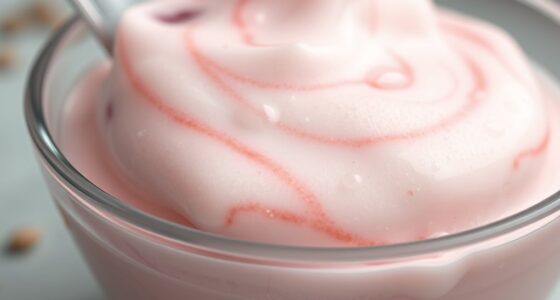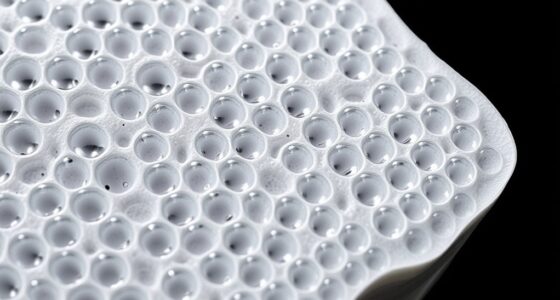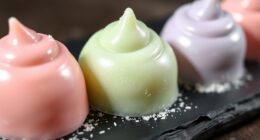Freezing point depression happens when you add a substance like salt or antifreeze to water, disrupting its ability to form ice. These solutes interfere with water molecules, lowering the temperature needed to freeze it. By doing so, they keep liquids liquid even in cold conditions, which is why salt is used on icy roads and antifreeze in car engines. If you want to understand how this principle works in everyday life, keep exploring.
Key Takeaways
- Freezing point depression occurs when solutes like salt or alcohol interfere with water’s ability to form a solid.
- Dissolving substances lower the freezing temperature, making liquids remain soft or liquid at lower temperatures.
- It is commonly applied in winter road de-icing and automotive antifreeze to prevent solidification in cold conditions.
- Increased solute concentration enhances the cryoscopic effect, further reducing a liquid’s freezing point.
- The principle extends to food preservation, where salt or sugar prevents spoilage by lowering the freezing point.

Have you ever wondered why adding salt to icy roads helps melt the ice? The answer lies in a fascinating scientific principle called freezing point depression. When you introduce salt into water, it disrupts the water molecules’ ability to form a solid. This phenomenon is rooted in cryoscopic effects, which describe how dissolving a solute like salt lowers the freezing point of a solvent, in this case, water. Fundamentally, the salt ions interfere with the orderly arrangement of water molecules needed to turn into ice. Because of this, the temperature must drop even further than usual to freeze the water. That’s why salted roads don’t freeze as easily in winter and why salt is a common tool for de-icing.
This concept extends beyond winter roads and has practical applications in various industries, especially in antifreeze solutions used in automobiles. Vehicles rely on antifreeze mixtures—usually a combination of water and ethylene glycol or propylene glycol—to prevent the coolant from freezing in cold weather. These solutions leverage freezing point depression to remain liquid at temperatures well below zero. By lowering the freezing point of the coolant, antifreeze applications ensure your engine stays protected and operational regardless of harsh winter conditions. This is a direct application of cryoscopic effects, which allow engineers to fine-tune the mixture’s composition to achieve specific freezing points suited for different climates.
Understanding how freezing point depression works can also help you grasp why certain liquids behave differently under cold conditions. For example, alcohol-based solutions or antifreeze liquids don’t freeze as easily as pure water because their solutes disrupt the formation of ice crystals. The more solute you add, the greater the cryoscopic effects, and the lower the temperature at which the liquid freezes. Additionally, incorporating kitchen ingredients like salt or sugar in food preservation demonstrates this principle by lowering the freezing point and preventing spoilage. The principle doesn’t just apply to roads and cars; it’s also involved in food preservation, where salt or sugar is used to lower the freezing point of solutions, preventing spoilage and extending shelf life.
Frequently Asked Questions
How Does Freezing Point Depression Affect Everyday Household Items?
Freezing point depression affects your household items by preventing ice formation at typical winter temperatures, especially when salts or other chemicals are present. You notice this in applications like de-icing your driveway or melting ice on your windshield. In household applications, it helps keep frozen foods from solidifying too hard and prevents ice buildup in pipes. This science guarantees your household items work efficiently and stay protected during cold weather.
Can Freezing Point Depression Be Used to Preserve Food Longer?
Ever wondered if freezing point depression can help you keep food fresh longer? Absolutely! By lowering the freezing point, you can enhance food preservation and extend shelf life. This principle is useful in culinary applications like making ice cream or preserving delicate ingredients. Using freezing point depression strategically allows you to prevent spoilage and maintain flavors, making it a valuable tool for both home cooks and food scientists.
What Materials Are Most Effective at Lowering Freezing Points?
You’ll find that antifreeze compounds like ethylene glycol and propylene glycol are most effective at lowering freezing points, especially in automotive and industrial applications. Salt solutions, such as sodium chloride or calcium chloride, also work well because they disrupt ice formation. When you mix these materials with water, they prevent freezing at lower temperatures, making them ideal for de-icing roads or preserving items in cold environments.
Are There Environmental Impacts of Using Freezing Point Depressants?
Think of freezing point depressants as double-edged swords; while they keep roads safe, they can harm the environment. You should know that these chemicals may cause environmental toxicity, affecting plants and animals. They can also lead to ecosystem disruption, altering natural balances. By using them, you’re risking more than just icy roads—you’re possibly damaging wildlife and water quality, so consider eco-friendly alternatives whenever possible.
How Does Temperature Variation Influence Freezing Point Depression?
You’ll notice temperature variation *considerably* impacts freezing point depression because as temperatures fluctuate, it influences the thermal conductivity of the solution, affecting how heat transfers during a phase transition. When temperatures drop, the depressants lower the freezing point, preventing ice formation. Conversely, rising temperatures can reduce this effect, making it easier for the solution to undergo phase transition, which is *vital* in applications like de-icing and climate control.
Conclusion
So, next time you see a frosty window or hear about salt melting ice, remember it’s all about freezing point depression. It’s funny how science sneaks into everyday moments, making them a little easier to handle. Just like how a splash of salt can surprise your day, understanding this phenomenon makes you notice the little coincidences around you. Science isn’t just in textbooks; it’s in those everyday moments that make life a little softer and warmer.










